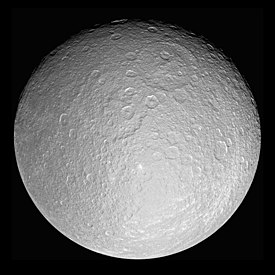Rhea (muin)
Appearance
 Cassini mosaic o Rhea | |||||||||
| Discovery | |||||||||
|---|---|---|---|---|---|---|---|---|---|
| Discovered bi | G. D. Cassini[1] | ||||||||
| Discovery date | December 23, 1672[1] | ||||||||
| Designations | |||||||||
| Saturn V | |||||||||
| Adjectives | Rhean | ||||||||
| Orbital chairactereestics [2] | |||||||||
| 527108 km | |||||||||
| Eccentricity | 0.0012583 | ||||||||
| 4.518212 d | |||||||||
Average orbital speed | 8.48 km/s[a] | ||||||||
| Inclination | 0.345° (tae Saturn's equator) | ||||||||
| Satellite o | Saturn | ||||||||
| Pheesical chairacteristics | |||||||||
| Dimensions | 1532.4 × 1525.6 × 1524.4 km [3] | ||||||||
Mean radius | 763.8±1.0 km [3] | ||||||||
Surface area | 7337000 km2 | ||||||||
| Mass | (2.306518±0.000353)×1021 kg [4] (~3.9×10−4 Yirds) | ||||||||
Mean density | 1.236±0.005 g/cm³ [3] | ||||||||
| 0.265 m/s² | |||||||||
| 0.635 km/s | |||||||||
| 4.518212 d (synchronous) | |||||||||
| zero | |||||||||
| Albedo | 0.949±0.003 (geometric) [5] | ||||||||
| |||||||||
| 10 [6] | |||||||||
Rhea (Ancient Greek: Ῥέᾱ) is the seicont-lairgest muin o Saturn an the nint-lairgest muin in the Solar Seestem.
Notes
[eedit | eedit soorce]- ↑ Calculatit on the basis o ither parameters.
References
[eedit | eedit soorce]- ↑ a b Rhea: Saturn's dirty snowball moon
- ↑ Natural Satellites Ephemeris Service Minor Planet Center
- ↑ a b c Roatsch, T.; Jaumann, R.; Stephan, K.; Thomas, P. C. (2009). "Cartographic Mapping of the Icy Satellites Using ISS and VIMS Data". Saturn from Cassini-Huygens. pp. 763–781. doi:10.1007/978-1-4020-9217-6_24. ISBN 978-1-4020-9216-9.
- ↑ Jacobson, R. A.; Antreasian, P. G.; Bordi, J. J.; Criddle, K. E.; Ionasescu, R.; Jones, J. B.; Mackenzie, R. A.; Meek, M. C.; Parcher, D.; Pelletier, F. J.; Owen, Jr., W. M.; Roth, D. C.; Roundhill, I. M.; Stauch, J. R. (December 2006). "The Gravity Field of the Saturnian System from Satellite Observations and Spacecraft Tracking Data". The Astronomical Journal. 132 (6): 2520–2526. Bibcode:2006AJ....132.2520J. doi:10.1086/508812.
- ↑ Verbiscer, A.; French, R.; Showalter, M.; Helfenstein, P. (9 Februar 2007). "Enceladus: Cosmic Graffiti Artist Caught in the Act". Science. 315 (5813): 815. Bibcode:2007Sci...315..815V. doi:10.1126/science.1134681. PMID 17289992. Retrieved 20 December 2011. (supporting online material, table S1)
- ↑ Observatorio ARVAL (15 Apryle 2007). "Classic Satellites of the Solar System". Observatorio ARVAL. Archived frae the original on 22 October 2013. Retrieved 17 December 2011.
